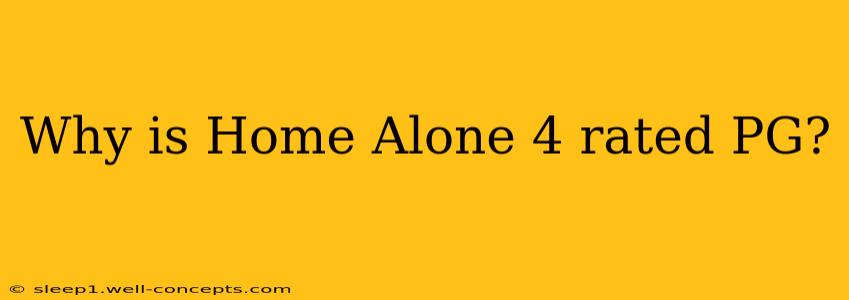Home Alone 4: Taking Back the House, unlike its predecessors, received a PG rating from the Motion Picture Association of America (MPAA). This rating, while seemingly innocuous, warrants a closer examination of the film's content and why it differed from the largely G-rated (or PG-rated for more minor instances of slapstick violence) preceding films. Understanding the nuances of the MPAA's rating system helps decipher why this specific installment earned its PG designation.
Understanding the PG Rating
The MPAA defines a PG rating as signifying that "some material may not be suitable for young children." This implies the presence of content that, while not explicitly violent or sexually suggestive, might be too intense or frightening for very young viewers. This contrasts with a G rating, which suggests suitability for all ages.
Specific Content in Home Alone 4 Contributing to its PG Rating
While Home Alone 4 maintains the slapstick comedy central to the franchise, several factors likely contributed to its PG rating:
1. Increased Emphasis on Slightly More Risky Situations:
Although still largely comedic, some sequences in Home Alone 4 place the protagonist, Kevin McCallister, in slightly more perilous situations than in previous films. While these are ultimately resolved humorously and without serious injury, the potential for harm might have factored into the MPAA's decision. The heightened stakes, even if played for laughs, might have been deemed unsuitable for very young, unsupervised children.
2. Mild Peril and Suspense:
The film includes sequences of mild peril and suspense, particularly those involving the villainous characters and their attempts to infiltrate the McCallister home. While not graphic or terrifying, the suspenseful elements could be unsettling for younger children, leading to the PG rating. The tension built around the burglar's attempts, although ultimately comedic, is more pronounced than in previous installments.
3. Enhanced Slapstick Violence:
While the slapstick violence remains a core element of the Home Alone franchise, the intensity and frequency of some comedic pratfalls in Home Alone 4 may have marginally exceeded the threshold for a G rating. Although the slapstick is exaggerated and played for laughs, some elements might have been deemed slightly more intense than the slapstick in the earlier films.
4. Subtle Thematic Elements:
The film touches upon themes of family, responsibility, and overcoming adversity. While these are positive messages, certain scenes might subtly hint at more mature themes, prompting the MPAA to issue a PG rating rather than a G.
Comparison to Previous Home Alone Films
The earlier Home Alone films largely avoided the more intense sequences found in Home Alone 4. Their comedic violence was lighter, and the overall tone was more consistently playful. This is a crucial distinction when analyzing the rating difference.
Conclusion: A Subtle Shift in Tone and Content
The PG rating for Home Alone 4 signifies a subtle but noticeable shift in the film's tone and content compared to its predecessors. While retaining the spirit of the original films, the increased emphasis on mildly perilous situations, enhanced slapstick, and slightly more intense suspenseful sequences warranted a more restrictive rating from the MPAA, ensuring parental guidance for younger viewers. This analysis provides a clearer understanding of why this specific film earned its PG rating while other films in the franchise didn't necessarily achieve the same.

